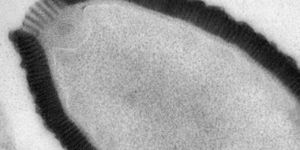Microbiology
Giant Active Virus Found in Siberian Permafrost
MAR 10, 2014 12:00 AM PDT
Share
Recharging Mechanisms Reduce Methane Production in Wetlands
 Wetlands, such as peat bogs, generally include a high content of humic organic compounds that are byproducts of an incomplete breakdown process of organic matter. Methane is often formed and released by the microorganisms that live in these environments-so much so that wetlands are estimated to be responsible for anywhere between 15-40% of the worldwide atmospheric input of methane, a well-known greenhouse gas.
Wetlands, such as peat bogs, generally include a high content of humic organic compounds that are byproducts of an incomplete breakdown process of organic matter. Methane is often formed and released by the microorganisms that live in these environments-so much so that wetlands are estimated to be responsible for anywhere between 15-40% of the worldwide atmospheric input of methane, a well-known greenhouse gas. However, some wetland areas put out a proportionately lower amount of methane based on their surface areas and their corresponding microbial systems. There must be at least one other process that is influencing methane production in these wetlands. A research team from ETH-Zurich and the University of Tubingen has discovered the potential answer to this phenomena-in essence an electrical process. Their work was recently summarized in Nature Geoscience.
In the anoxic (oxygen-free) conditions within the wetlands, anaerobic microorganisms use the nearby humic compounds as electron acceptors-as part of their respiration process-much in the same way that humans use oxygen in our respiration process.
Unlike humans, who have a massive supply of oxygen to work with, the microorganisms saturate the humic compounds until they can no longer accept electrons. At that point, the microorganisms must search for other electron-accepting materials. Whenever that electron-accepting material is carbon dioxide, methane is formed.
Since some wetlands are discharging proportionately less methane than others, it's reasonable to think that either another electron-accepting material besides carbon dioxide is being used, or the humic material is discharging its electrons and periodically replenishing its capacity.
The research team was able to show in a model system that an electron discharge mechanism is indeed allowing wetlands to replenish. The water level is key. A static water level keeps the wetlands anoxic, whereas a dropping water level exposes portions of the humic material to oxygen, allowing a release of electrons from the humic material.
If the water level rises and the previous exposed areas are underwater again, eventually becoming anoxic, the humic material can again act as the electron acceptor for the microorganisms. The effect is like a giant rechargeable battery, with the humic material being "charged" to capacity by the microorganisms and "discharging" to the oxygenated environment.
The model system used an anaerobic bacterium known as Shewanella oneidensis MR-1, a system that can live in both anoxic and oxygen-bearing conditions, along with four humic materials as different electron acceptors. Using the results of the model system, they were able to estimate the effect on larger wetland areas.
With a lower-emitting peatland as a reference, the research team estimated that the absence of this recharging mechanism would increase the amount of methane by up to 170%. This leads to the question: can the recharging mechanism be instituted in wetlands that don't normally undergo this process?
It's not a simple issue, because merely manipulating the water level of wetlands is impractical and could have unintended consequences even if it were practical. However, further study of the mechanism may lead to the discovery of other methods of recharging the humic material, and allow us to manipulate the overall carbon cycle in our favor.
You May Also Like
Loading Comments...








